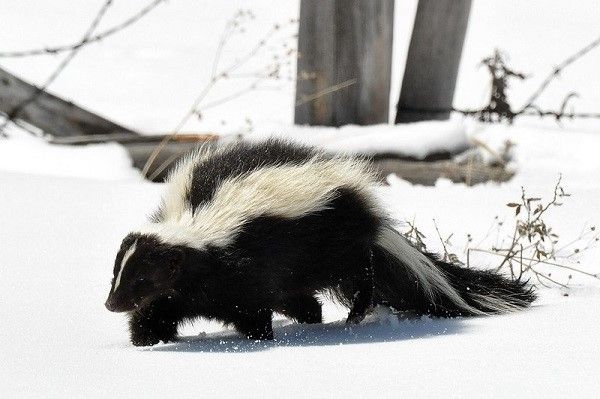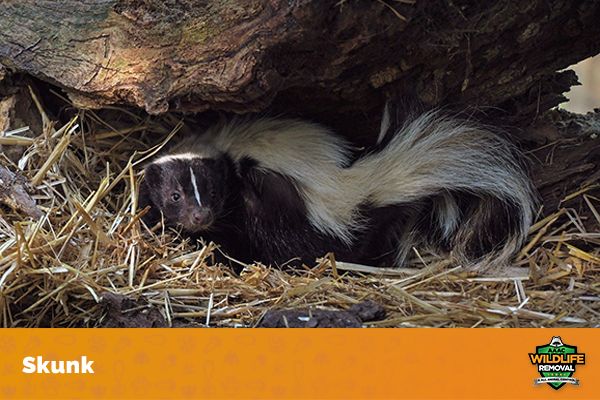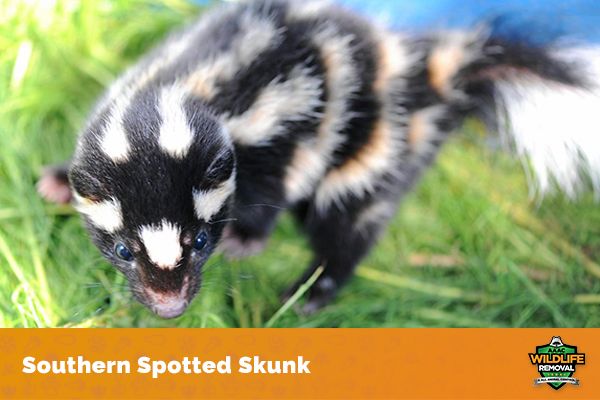
11/28/2022 5 minute read
Identifying Different Types of Skunks
Skunks are made up of over 12 species with distinct colorations and patterns. Most skunks are black and white but can also be a unique mix of cream, brown, gray, and red. Often, you’ll see skunks with stripes on their backs, while others exhibit spots. But some may have no lines at all! All these patterns will help you identify what type of skunks they are.
Skunks also vary in size. The hog-nosed skunk is the largest known of their kind, weighing up to 10 pounds. At the same time, the smallest one is the striped skunk, which only weighs about 4 pounds.
There are several others that do not only differ in size but also in coloration and pattern on their bodies. Let’s find out what they are!

Common Types of Skunks
We all know that skunks are infamous for the foul and pungent odor they release from their anal glands. But, only a few can differentiate and correctly identify the specific members of their family.
In North America, several types of skunks exist. They are considered pests and annoying because of the malodorous skunk spray. While this may be true, knowing and identifying their species remains essential.
So, what are these species, and how do they differ?

Striped Skunk
The striped skunk or Mephitis mephitis is the most common type of skunk. They can be identified with a black and white stripe down their back. They are the most widespread in North America and have increased distribution across their native range in Southern Canada and Mexico.
As mentioned, striped skunks are relatively small, with weight reaching up to 4 pounds. They are omnivorous animals, which means they feed on meat and plants. These species do not usually hibernate but become inactive and den, especially during the challenging periods of extreme winter.
Striped skunks tend to linger in open areas with habitats like woods and grasslands. But, they are very versatile mammals and can survive in various habitats and land types. Typically, they never go farther than 2 miles from water.
Striped skunks usually mate from mid-February to mid-March.

Hooded Skunk
The Mephitis macroura, commonly known as Hooded Skunk, is a skunk type from North and Central America. They are popularly known as hooded skunks due to the white markings around their necks, which somewhat resemble a hood. These skunks are nocturnal animals that prefer staying in woodlands. But they can also be found in other habitats, such as grasslands and deserts.
Generally, they have a more slender body than striped skunks but are larger than spotted skunks. Their total body lengths range from 11 to 13 inches, a tail length of approximately 14.5 inches, and weight typically of .4 to .9 kilograms.

Southern Spotted Skunk
We also have the Southern Spotted Skunk or Spilogale angustifrons. These skunks are native to Central America and range from Central American states like Guatemala, Honduras, Belize, Nicaragua, and Mexico, the southern state of North America. Similar to the striped skunk, these skunks are dominantly black and white. The only difference is that these species are black with white spots, not stripes.
The Southern spotted skunks are small and weigh up to 4 pounds, like the other types of skunk. They are nocturnal and secretive in behavior. They climb trees but primarily forage insects, birds, eggs, grain, and fruit on the ground.

Eastern Spotted Skunk
On the other hand, Eastern Spotted Skunk or Spilogale putorius is a skunk species found throughout the eastern United States and in selected portions of Canada and Mexico. This small skunk can be compared to a weasel for its body, which is different from the familiar striped skunk. These species are more agile in nature, have longer tails, and climb trees. They are black with white spots on the back and sides.
In addition, eastern spotted skunks are pretty secretive and crafty creatures, and it’s somewhat rare to see them. They become more active during dry, cool nights rather than warm wet nights.
Western Spotted Skunk
The almost similar stripes that run down the back and sides of the eastern and the western spotted skunk may seem confusing but What makes these species distinguishable is the more extensive white stripe. This skunk is much smaller than the striped skunk and has a long, narrow head.
Western spotted skunks are found in the west of the United States, particularly in the states of Washington, Oregon, California, Colorado, New Mexico, Nevada, Utah, and Arizona.
Usually, these skunks have two large spots on the shoulders and two rows of smaller spots on the sides. They have a black tail with a white tip. They are nocturnal creatures that love to feast on small invertebrates like mollusks, insects, frogs, lizards, snakes, and rodents.

Pygmy Spotted Skunk
The pygmy spotted skunk or Spilogale pygmaea is one of the smallest spotted skunks, which is also one of the smallest skunks in the world. These species appear slightly different from other skunks due to their slimmer body and tailcoat thinner that is smaller. They are black on the rest, except for the 2 white spots on the forehead and stripes that can be 2-6 on their back and flanks.
These skunk species are omnivorous in nature. But, they are the most carnivorous in the entire skunk family. During the hot months of summer, they eat insects, moths, and berries. While on winter, they specifically forage for reptiles, birds, and small mammals. This is because insects and fruits wilt and temporarily becomes unavailable.
The adults of this species only grow up to 8 inches in length (without the tail) and weigh around 6 ounces.
Striped Hog-Nosed Skunk
The striped hog-nosed skunk or Conepatus semistriatus is a hog-nosed skunk species found in southern regions of Mexico to the northern areas of Peru. They are tagged as generalist species mainly because of their capacity to withstand disturbed environments. This includes carrasco, pastures, semi-deciduous forests, and even primary rainforests. These species can also be found in the Andean mountain range at an elevation of up to 3,000 m.
As their name suggests, these skunks are characterized by the presence of a white stripe that runs down their entire back from the neck all the way to the base of the tail. The rest of their body is black in color. Another notable feature of these creatures is their long snout, longer than a usual skunk.

American Hog-Nosed Skunk
The American hog-nosed skunk (Conepatus leuconotus) is one of the largest skunks in the world. They are the largest member of the skunk family and can grow up to 3 feet in length (including the tail). These creatures are characterized by their long snout, almost twice the length of their head. They also have small eyes and ears.
The American hog-nosed skunk is found in North and Central America. These creatures are referred to as the rooter skunk in Texas because of their exciting hobby of overturning rocks in search of food. These skunks are also proficient swimmers and can often be seen wading in streams and ponds.

Humboldt’s Hog-Nosed Skunk
Also referred to as the Patagonian skunk, the Humboldt’s hog-nosed skunk (Conepatus humboldtii) is native to the open grassed areas in the Patagonian regions of Chile and Argentina. These species are small and stocky. They have two white, parallel stripes on their flanks and brownish-red fur. They have an elongated nose which becomes handy for finding ground insects like beetles, crickets, and grasshoppers.
This skunk also has specialized teeth, which help consume fruits and invertebrates like crabs, snails, and slugs. Their lower molar teeth are specially built for eating hard foods.

Molina’s Hog-Nosed Skunk
Also called the Andes Skunk, the Molina’s hog-nosed skunk (Conepatus chinga) is a skunk species found in South America, specifically in Uruguay, Paraguay, Bolivia, Peru, Ecuador, Colombia, and Chile. They can be found at elevations up to 5000 meters.
These hog-nosed skunks are characterized by their long snout and short legs. They also have a white stripe on their backs which extends from the neck to the base of the tail. The rest of their body is black in color.
This skunk has a highly adaptive teeth anatomy different from their species and other mammals. Their teeth are specialized for omnivorous consumption, with grinding being the dominant function.

Have A Skunk Problem?
AAAC Wildlife Removal has effective solutions for skunk problems. Our team is equipped and always ready to serve, whether skunk deterring or skunk removal.
AAAC Wildlife Removal is not just limited to skunk infestation. We can solve any wildlife infestation, such as squirrels, raccoons, bats, gophers, rodents, and other unusual creatures. Call us today!
Conclusion
Skunks, indeed, are one of the most amazing furry wildlife creatures today. Their distinct colorations and features make them stand out among other animals. Although they are often associated with a negative connotation, these creatures benefit the environment.
These animals only have a few species with them, 12 to count. This includes the striped skunk, hooded skunk, and hog-nosed skunks. Despite that, each has a unique physical appearance that differentiates one from the other. Some have several white spots, while some only have two stripes running on their flanks.
Humans often misunderstand skunks. They are, however, gentle animals that only want to be left alone. Although they have potent defense mechanisms, they will only use them as a last resort when all other options have been exhausted.
To learn more about skunk identification and their fascinating characteristics, click here: skunk identification.
FAQs
Are stink badgers related to skunks?
Stink badgers, popularly called false badgers, belong to the genus Mydaus of the skunk family. Like typical skunks, they secrete a smelly and pungent liquid from their anal glands that reek a decaying, putrid smell. There are only two species. The Palawan stink badger and the Sunda stink badger.







